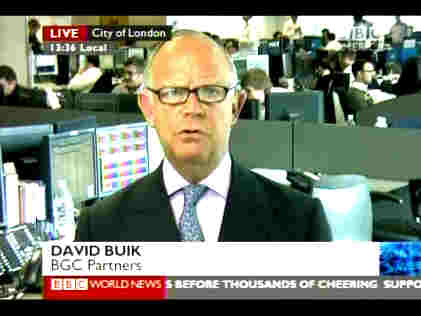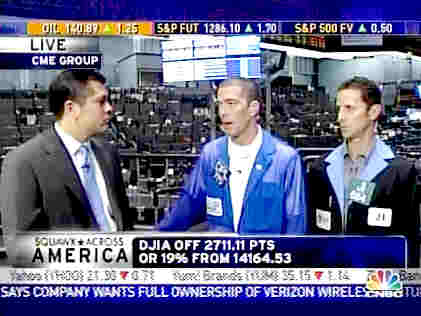
Dynamics

|
Generational Dynamics |
| Forecasting America's Destiny ... and the World's | |
| HOME WEB LOG COUNTRY WIKI COMMENT FORUM DOWNLOADS ABOUT | |
Traders are hoping for a "mini-panic." Be careful what you wish for.
Ten days ago, the Royal Bank of Scotland issued global stock crash alert, saying, "A very nasty period is soon to be upon us - be prepared."
The nasty period appeared to have already begun on Thursday, as the Wall Street markets fell to their lowest levels since September, 2006. The month is now on track to be the worst June since the Great Depression.
 |
Financial analysts were generally very negative about the outlook early Friday morning.
David Buik, of BGC Partners in London said:
There was none of the usual crazy optimism that's been so prevalent in the past. In the past, we frequently heard, "It's good news that things are so bad, because that means the worst is over, and the market will go up again." Everyone is now very grim, and this is a marked change.
On Friday morning, CNBC's Carl Quintanilla interviewed stock traders Ben Lichtenstein of Tradersaudio.com and Jim Iuorio of TJM Institutional Services:
Jim Iuorio: "Things are so strong negatively now.... Yesterday, there really was no huge panic at any one time. As traders, what we look for is that sort of capitulation with people crawling all over each other to get to the exits to signal the short-term bottom, and we didn't really see that. It was kind of an orderly break, even though it went on through the whole day.
 |
It was just people concluding that it was either going to trade sideways or negatively. Throughout the day, traders were getting out. ... We haven't gotten to that big level yet, where everyone's going to be pounding out."
Lichtenstein: "I really feel that the market still has a ways to go. Rather than seeing the pressure of a high energy selloff, we're seeing the lack of a buyer right now. And that is concerning to me. I think that the markets are going to go a little bit further till we clean it out and then head back up."
Iuorio: "There's a certain feel that happens -- it's unmistakable -- when everybody really feels so distraught that everyone heads out at the same time and the market gaps lower -- moves lower real quickly. And that's when traders come in and that's when traders come in and think, "They've blinked." Now it's time to come in and we establish a short-term bottom. And we haven't seen it yet, but we could real soon."
What's interesting about this is the desire and expectation of what might be called a "mini-panic." We can try to match up this desire with what happened just prior to the 1929 crash. If we look at my Dow Jones historical page, we can see what happened before the 1929 crash, some of which is extracted here:
1929: Daily change in Dow Industrials
--------------------
Mon 10-07 ( +6.32%)
Tue 10-08 ( -0.21%)
Wed 10-09 ( +0.48%)
Thu 10-10 ( +1.79%)
Fri 10-11 ( -0.05%)
-------------------
Mon 10-14 ( -0.49%)
Tue 10-15 ( -1.06%)
Wed 10-16 ( -3.20%)
Thu 10-17 ( +1.70%)
Fri 10-18 ( -2.51%)
------------------
Mon 10-21 ( -3.71%)
Tue 10-22 ( +1.75%)
Wed 10-23 ( -6.33%)
Thu 10-24 ( -2.09%) Black Thursday
Fri 10-25 ( +0.58%)
-------------------
Mon 10-28 (-13.47%) Black Monday
Tue 10-29 (-11.73%)
Wed 10-30 (+12.34%)
Thu 10-31 ( +5.82%)
Fri 11-01 (Closed)
-------------------
Mon 11-04 ( -5.79%)
Tue 11-05 (Closed)
Wed 11-06 ( -9.92%)
Thu 11-07 ( +2.61%)
Fri 11-08 ( -0.70%)
-------------------
Mon 11-11 ( -6.82%)
Tue 11-12 ( -4.83%)
Wed 11-13 ( -5.27%)
Thu 11-14 ( +9.36%)
Fri 11-15 ( +5.27%)
-----------------
Let's imagine that in 1929 there were traders just like Lichtenstein and Iuorio, waiting for a "mini-panic," which would mean a market bottom and a time to buy. What happened on 10/23/1929 would fit the bill -- a sudden 6.33% market plunge. They might have taken that as the mini-panic they were looking for.
Black Thursday came next. That was a very tumultuous day, with wide swings up and down. Lichtenstein and Iuorio would have been expecting an up market, so they would been on the "buy" side. Meanwhile, the great unwashed masses, who didn't have such a sophisticated understanding of why a mini-panic was such good news, were on the "sell" side, and really sold off on Black Monday and Tuesday.
By that time, Lichtenstein and Iuorio and others like them would have been convinced that things couldn't POSSIBLY get any worse, so they pushed the market back up 18% by the end of the week. Unfortunately for them, the market didn't start going up again to new bubble heights, and kept falling until 1933, at which time it had fallen 90% from it's 1929 high.
So these statements by Lichtenstein and Iuorio give us further insight into what's going on, and why any coming stock market crash is going to be accompanied by wild up and down swings that will fool a lot of people, leading to the Principle of Maximum Ruin -- the maximum number of people will be ruined to the maximum possible extent.
The real problem is that the basic math hasn't changed, as I began describing in 2002, and summarized last year in "How to compute the 'real value' of the stock market." The stock market is overpriced by a factor of well over 200%, and by the Law of Mean Reversion, a crash must occur.
Even if you ignore the possibility of a crash, a stock market rally is almost impossible right now, because corporate earnings and earnings estimates have been falling. Price/earnings ratios (also called valuations) are being pushed to stratospheric levels again, whether or not there's a crash. See: "Stock markets plunge on unemployment and historic oil price spike" and: "Price/earnings stock index continues to surge higher and higher."
I've estimated that the probability of a major financial crisis (generational stock market panic and
crash) in any given week from now on is about 3%. The probability of
a crisis some time in the next 52 weeks is 75%, according to this
estimate.
(27-Jun-2008)
Permanent Link
Receive daily World View columns by e-mail
Donate to Generational Dynamics via PayPal
Web Log Summary - 2016
Web Log Summary - 2015
Web Log Summary - 2014
Web Log Summary - 2013
Web Log Summary - 2012
Web Log Summary - 2011
Web Log Summary - 2010
Web Log Summary - 2009
Web Log Summary - 2008
Web Log Summary - 2007
Web Log Summary - 2006
Web Log Summary - 2005
Web Log Summary - 2004
Web Log - December, 2016
Web Log - November, 2016
Web Log - October, 2016
Web Log - September, 2016
Web Log - August, 2016
Web Log - July, 2016
Web Log - June, 2016
Web Log - May, 2016
Web Log - April, 2016
Web Log - March, 2016
Web Log - February, 2016
Web Log - January, 2016
Web Log - December, 2015
Web Log - November, 2015
Web Log - October, 2015
Web Log - September, 2015
Web Log - August, 2015
Web Log - July, 2015
Web Log - June, 2015
Web Log - May, 2015
Web Log - April, 2015
Web Log - March, 2015
Web Log - February, 2015
Web Log - January, 2015
Web Log - December, 2014
Web Log - November, 2014
Web Log - October, 2014
Web Log - September, 2014
Web Log - August, 2014
Web Log - July, 2014
Web Log - June, 2014
Web Log - May, 2014
Web Log - April, 2014
Web Log - March, 2014
Web Log - February, 2014
Web Log - January, 2014
Web Log - December, 2013
Web Log - November, 2013
Web Log - October, 2013
Web Log - September, 2013
Web Log - August, 2013
Web Log - July, 2013
Web Log - June, 2013
Web Log - May, 2013
Web Log - April, 2013
Web Log - March, 2013
Web Log - February, 2013
Web Log - January, 2013
Web Log - December, 2012
Web Log - November, 2012
Web Log - October, 2012
Web Log - September, 2012
Web Log - August, 2012
Web Log - July, 2012
Web Log - June, 2012
Web Log - May, 2012
Web Log - April, 2012
Web Log - March, 2012
Web Log - February, 2012
Web Log - January, 2012
Web Log - December, 2011
Web Log - November, 2011
Web Log - October, 2011
Web Log - September, 2011
Web Log - August, 2011
Web Log - July, 2011
Web Log - June, 2011
Web Log - May, 2011
Web Log - April, 2011
Web Log - March, 2011
Web Log - February, 2011
Web Log - January, 2011
Web Log - December, 2010
Web Log - November, 2010
Web Log - October, 2010
Web Log - September, 2010
Web Log - August, 2010
Web Log - July, 2010
Web Log - June, 2010
Web Log - May, 2010
Web Log - April, 2010
Web Log - March, 2010
Web Log - February, 2010
Web Log - January, 2010
Web Log - December, 2009
Web Log - November, 2009
Web Log - October, 2009
Web Log - September, 2009
Web Log - August, 2009
Web Log - July, 2009
Web Log - June, 2009
Web Log - May, 2009
Web Log - April, 2009
Web Log - March, 2009
Web Log - February, 2009
Web Log - January, 2009
Web Log - December, 2008
Web Log - November, 2008
Web Log - October, 2008
Web Log - September, 2008
Web Log - August, 2008
Web Log - July, 2008
Web Log - June, 2008
Web Log - May, 2008
Web Log - April, 2008
Web Log - March, 2008
Web Log - February, 2008
Web Log - January, 2008
Web Log - December, 2007
Web Log - November, 2007
Web Log - October, 2007
Web Log - September, 2007
Web Log - August, 2007
Web Log - July, 2007
Web Log - June, 2007
Web Log - May, 2007
Web Log - April, 2007
Web Log - March, 2007
Web Log - February, 2007
Web Log - January, 2007
Web Log - December, 2006
Web Log - November, 2006
Web Log - October, 2006
Web Log - September, 2006
Web Log - August, 2006
Web Log - July, 2006
Web Log - June, 2006
Web Log - May, 2006
Web Log - April, 2006
Web Log - March, 2006
Web Log - February, 2006
Web Log - January, 2006
Web Log - December, 2005
Web Log - November, 2005
Web Log - October, 2005
Web Log - September, 2005
Web Log - August, 2005
Web Log - July, 2005
Web Log - June, 2005
Web Log - May, 2005
Web Log - April, 2005
Web Log - March, 2005
Web Log - February, 2005
Web Log - January, 2005
Web Log - December, 2004
Web Log - November, 2004
Web Log - October, 2004
Web Log - September, 2004
Web Log - August, 2004
Web Log - July, 2004
Web Log - June, 2004